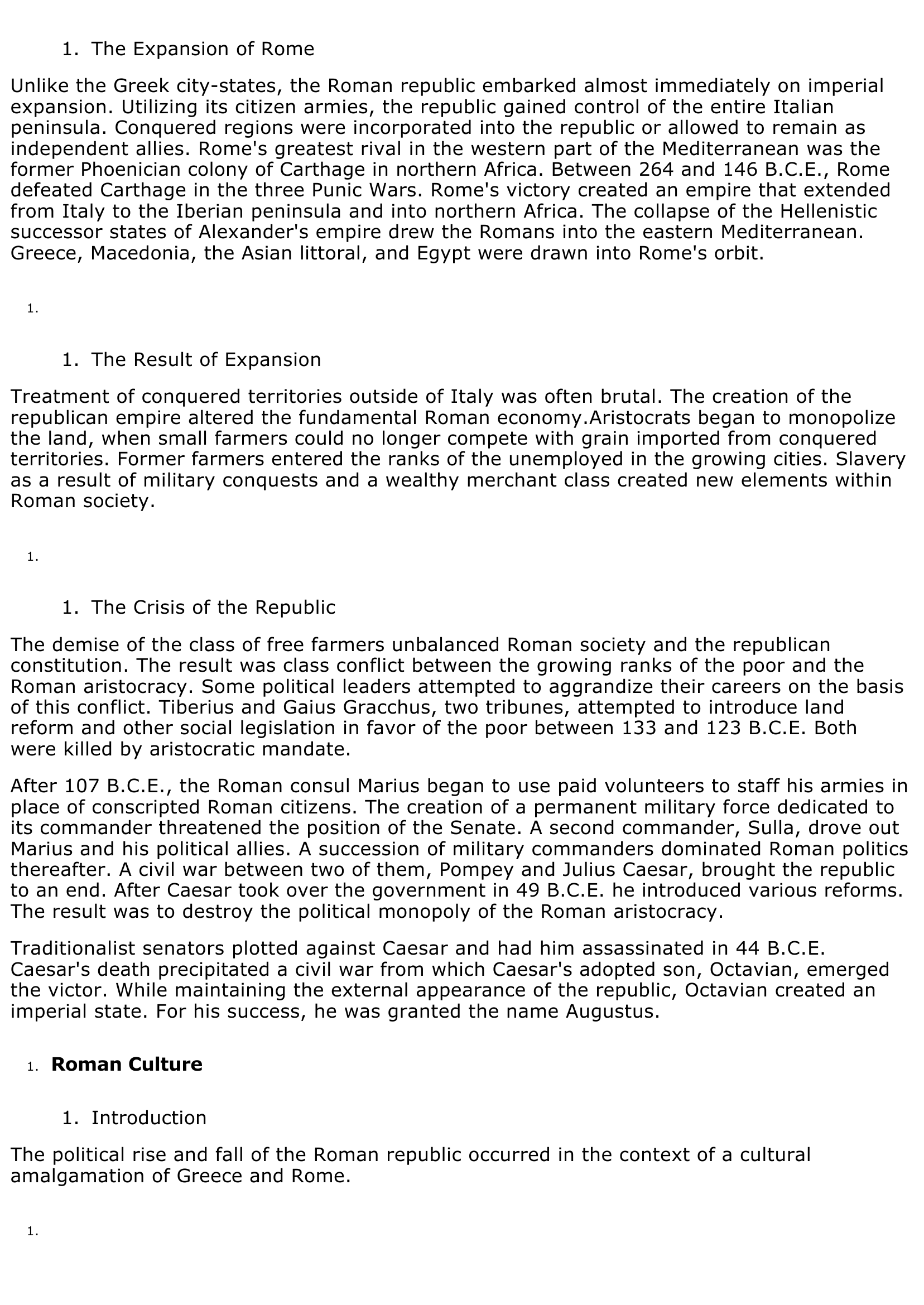Rome and Its Empire
Publié le 22/05/2012

Extrait du document
Rome and Its Empire
-
Introduction
-
Classical Civilization in Italy
-
The stability that typified certain aspects of Chinese and Indian cultures was not present in the Mediterranean. The center of Mediterranean civilization shifted from Greece and its Hellenistic successor states to Rome. Rome developed during the fifth century B.C.E. in the Italian peninsula relatively independent of Greek civilization. After consolidating their hold on Italy, Rome prepared to expand not only into the western Mediterranean, but also into the areas of Hellenistic civilization. This new Roman empire lasted for four centuries before entering a prolonged period of decline. It demonstrated a greater degree of centralization and bureaucratic organization than Greek civilization had been able to attain.
«
The Expansion of Rome 1.
1.
Unlike the Greek city-states, the Roman republic embarked almost immediately on imperialexpansion.
Utilizing its citizen armies, the republic gained control of the entire Italianpeninsula.
Conquered regions were incorporated into the republic or allowed to remain asindependent allies.
Rome's greatest rival in the western part of the Mediterranean was theformer Phoenician colony of Carthage in northern Africa.
Between 264 and 146 B.C.E., Romedefeated Carthage in the three Punic Wars.
Rome's victory created an empire that extendedfrom Italy to the Iberian peninsula and into northern Africa.
The collapse of the Hellenisticsuccessor states of Alexander's empire drew the Romans into the eastern Mediterranean.Greece, Macedonia, the Asian littoral, and Egypt were drawn into Rome's orbit.
The Result of Expansion 1.
1.
Treatment of conquered territories outside of Italy was often brutal.
The creation of therepublican empire altered the fundamental Roman economy.Aristocrats began to monopolizethe land, when small farmers could no longer compete with grain imported from conqueredterritories.
Former farmers entered the ranks of the unemployed in the growing cities.
Slaveryas a result of military conquests and a wealthy merchant class created new elements withinRoman society.
The Crisis of the Republic 1.
1.
The demise of the class of free farmers unbalanced Roman society and the republicanconstitution.
The result was class conflict between the growing ranks of the poor and theRoman aristocracy.
Some political leaders attempted to aggrandize their careers on the basisof this conflict.
Tiberius and Gaius Gracchus, two tribunes, attempted to introduce landreform and other social legislation in favor of the poor between 133 and 123 B.C.E.
Bothwere killed by aristocratic mandate.
After 107 B.C.E., the Roman consul Marius began to use paid volunteers to staff his armies inplace of conscripted Roman citizens.
The creation of a permanent military force dedicated toits commander threatened the position of the Senate.
A second commander, Sulla, drove outMarius and his political allies.
A succession of military commanders dominated Roman politicsthereafter.
A civil war between two of them, Pompey and Julius Caesar, brought the republicto an end.
After Caesar took over the government in 49 B.C.E.
he introduced various reforms.The result was to destroy the political monopoly of the Roman aristocracy.
Traditionalist senators plotted against Caesar and had him assassinated in 44 B.C.E.Caesar's death precipitated a civil war from which Caesar's adopted son, Octavian, emergedthe victor.
While maintaining the external appearance of the republic, Octavian created animperial state.
For his success, he was granted the name Augustus.
Roman Culture
Introduction 1.
1.
The political rise and fall of the Roman republic occurred in the context of a culturalamalgamation of Greece and Rome.
1.
1..
»
↓↓↓ APERÇU DU DOCUMENT ↓↓↓
Liens utiles
- Julius Caesar I INTRODUCTION Julius Caesar (100-44 BC), Roman general and statesman whose dictatorship was pivotal in Rome's transition from republic to empire.
- VIE QUOTIDIENNE A ROME A L’APOGÉE DE L’EMPIRE (La) (résumé) Jérôme Carcopino
- Rome et l'Empire romain par Jean Gagé Membre du Collège de France Quand
- Justinien Ier par Evelyne Patlagean Chargée d'enseignement à la Faculté des Lettres et Sciences humaines de Caen Justinien Ier a cru restaurer, dans une splendeur qui ne finirait plus, l'Empire d'une Rome devenue chrétienne et byzantine.
- John Winthrop: "A City Upon a Hill" In 1629 English attorney and Puritan John Winthrop was chosen by the Massachusetts Bay Company, an English trading firm, to govern its colony in New England.

































